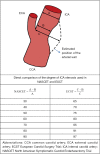Why are we still debating criteria for carotid artery stenosis?
- PMID: 33178802
- PMCID: PMC7607093
- DOI: 10.21037/atm-20-1188a
Why are we still debating criteria for carotid artery stenosis?
Abstract
The risk of new or recurrent stroke is high among patients with extracranial carotid artery stenosis and the benefit of carotid revascularization is associated to the degree of luminal stenosis. Catheter-based digital subtraction angiography (DSA) as the diagnostic gold-standard for carotid stenosis (CS) has been replaced by non-invasive techniques including duplex ultrasound, computed-tomography angiography, and magnetic resonance angiography (MRA). Duplex ultrasound is the primary noninvasive diagnostic tool for detecting, grading and monitoring of carotid artery stenosis due to its low cost, high resolution, and widespread availability. However, as discussed in this review, there is a wide range of practice patterns in use of ultrasound diagnostic criteria for carotid artery stenosis. To date, there is no internationally accepted standard for the gradation of CS. Discrepancies in ultrasound criteria may result in clinically relevant misclassification of disease severity leading to inappropriate referral, or lack of it, to revascularization procedures, and potential for consequential adverse outcome. The Society of Radiologists in Ultrasound (SRU), either as originally outlined or in a modified form, are the most common criteria applied. However, such criteria have received criticism for relying primarily on peak systolic velocities, a parameter that when used in isolation could be misleading. Recent proposals rely on a multiparametric approach in which the hemodynamic consequences of carotid narrowing beyond velocity augmentation are considered for an accurate stenosis classification. Consensus criteria would provide standardized parameters for the diagnosis of CS and considerably improve quality of care. Accrediting bodies around the world have called for consensus on unified criteria for diagnosis of CS. A healthy debate between professionals caring for patients with CS regarding optimal CS criteria still continues.
Keywords: Carotid artery stenosis; diagnostic criteria; ultrasound.
2020 Annals of Translational Medicine. All rights reserved.
Conflict of interest statement
Conflicts of Interest: All authors have completed the ICMJE uniform disclosure form (available at http://dx.doi.org/10.21037/atm-20-1188a). The series “Carotid Artery Stenosis and Stroke: Prevention and Treatment Part I” was commissioned by the editorial office without any funding or sponsorship. HLG reports other from Flexlife Health, outside the submitted work; and is a non-compensated member of the Board of Directors of IAC Vascular Testing. TR reports grants from National Institute of Health, outside the submitted work. The other author has no other conflicts of interest to declare.
Figures
Similar articles
-
Evaluation of the interrater and intermethod agreement of the German multiparametric ultrasound criteria for the grading of internal carotid artery stenosis.Neuroradiology. 2021 Apr;63(4):519-528. doi: 10.1007/s00234-020-02546-1. Epub 2020 Sep 18. Neuroradiology. 2021. PMID: 32945912 Free PMC article.
-
Ultrasonography Grading of Internal Carotid Artery Disease: Multiparametric German Society of Ultrasound in Medicine (DEGUM) versus Society of Radiologists in Ultrasound (SRU) Consensus Criteria.Ultraschall Med. 2022 Dec;43(6):608-613. doi: 10.1055/a-1487-5941. Epub 2021 May 5. Ultraschall Med. 2022. PMID: 33951737 English.
-
Carotid Duplex Velocity Criteria Recommended by the Society of Radiologists in Ultrasound and Endorsed by the Intersocietal Accreditation Commission Lack Predictive Ability for Identifying High-Grade Carotid Artery Stenosis.Ann Vasc Surg. 2019 Nov;61:227-232. doi: 10.1016/j.avsg.2019.05.051. Epub 2019 Aug 5. Ann Vasc Surg. 2019. PMID: 31394249
-
Searching the perfect ultrasonic classification in assessing carotid artery stenosis: comparison and remarks upon the existing ultrasound criteria.J Ultrasound. 2016 Feb 1;19(2):83-90. doi: 10.1007/s40477-016-0193-6. eCollection 2016. J Ultrasound. 2016. PMID: 27298648 Free PMC article. Review.
-
Interpretation of carotid duplex testing.Semin Vasc Surg. 2013 Jun-Sep;26(2-3):72-85. doi: 10.1053/j.semvascsurg.2014.01.003. Epub 2014 Jan 18. Semin Vasc Surg. 2013. PMID: 24636604 Review.
Cited by
-
Misclassification of carotid stenosis severity with area stenosis-based evaluation by computed tomography angiography: impact on erroneous indication to revascularization or patient (lesion) migration to a higher guideline recommendation class as per ESC/ESVS/ESO/SVS and CMS-FDA thresholds.Postepy Kardiol Interwencyjnej. 2022 Dec;18(4):500-513. doi: 10.5114/aic.2023.125610. Epub 2023 Feb 6. Postepy Kardiol Interwencyjnej. 2022. PMID: 36967857 Free PMC article.
-
Dysregulation Serum miR-19a-3p is a Diagnostic Biomarker for Asymptomatic Carotid Artery Stenosis and a Promising Predictor of Cerebral Ischemia Events.Clin Appl Thromb Hemost. 2021 Jan-Dec;27:10760296211039287. doi: 10.1177/10760296211039287. Clin Appl Thromb Hemost. 2021. PMID: 34558328 Free PMC article.
-
MicroRNA and Hemostasis Profile of Carotid Atherosclerosis.Int J Mol Sci. 2022 Sep 19;23(18):10974. doi: 10.3390/ijms231810974. Int J Mol Sci. 2022. PMID: 36142883 Free PMC article.
-
Role of carotid duplex in the assessment of carotid artery restenosis after endarterectomy or stenting.Front Neurol. 2023 Oct 27;14:1226220. doi: 10.3389/fneur.2023.1226220. eCollection 2023. Front Neurol. 2023. PMID: 37965176 Free PMC article.
-
A comprehensive scoping review of existing carotid duplex ultrasound scanning and reporting protocols: identifying gaps and opportunities for standardization of practice in low-income countries.J Ultrasound. 2025 Aug 28. doi: 10.1007/s40477-025-01064-1. Online ahead of print. J Ultrasound. 2025. PMID: 40866737 Review.
References
-
- Hall HA, Bassiouny HS. Pathophysiology of carotid atherosclerosis. In: Nicolaides A, Beach KW, Kyriacou E, et al. editors. Ultrasound Carotid Bifurc Atheroscler. New York: Springer; 2012:27-39.
Publication types
Grants and funding
LinkOut - more resources
Full Text Sources

